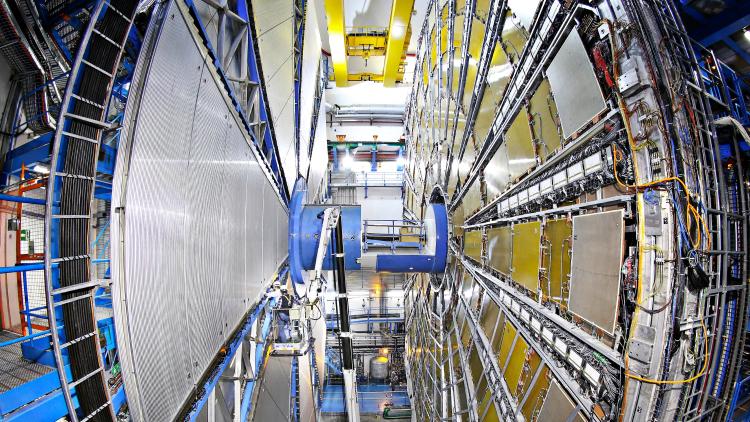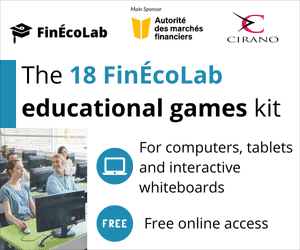U of A physicists Doug Gingrich, Roger Moore and James Pinfold are among the recipients of the 2025 Breakthrough Prize in Fundamental Physics, recognized for their significant contributions as part of the ATLAS team.
The ATLAS detector, located at the European Organization for Nuclear Research (CERN) in Switzerland, is a mammoth machine the height of an eight-story building with a weight of over 7,000 tonnes. It allows researchers to study a diverse range of particles and was instrumental in the discovery of the Higgs boson in 2012.
The data gathered there will help unravel the mysteries of our universe, from black holes to dark matter.

The calorimeters (pictured) were one of the elements of the ATLAS detector that U of A physicists were involved with as founding members of the ATLAS team. (Photo: CERN)
"If you really want to study fundamental physics, discovery physics, you probably want to do it with ATLAS," says Pinfold. "We were founding members of the ATLAS collaboration. We've made major contributions to the experiment and continue to make key contributions, punching way above our weight."
"We've been back and forth to CERN for 33 years of our lives," adds Gingrich, explaining that new detectors are constantly in development, and upgrades are made in the existing infrastructure in order to maintain the machine and keep it operating at its optimal level.
The complex, intricate and ultra-powerful ATLAS detector is a far cry from the secondhand milling machine that Pinfold and Gingrich acquired for the U of A back in the 90s through a partnership with TRIUMF, used to machine over 400 tonnes of copper absorber plates for the hadronic endcap calorimeter.
"One of the first jobs was to clean about a year of pigeon dung off of it before we could use it," says Pinfold, who arrived on campus in 1992 to start up a particle physics research program. Gingrich was the second hire and the two have been collaborators ever since, bringing their respective expertise to the ATLAS team.
Pinfold and Gingrich were involved with the design and construction of the liquid argon calorimeter, which surrounds the detector and measures the energy of particles.
"We both were involved in the design. I was building the detectors, and Doug did a huge amount of work on the electronics," says Pinfold. "I think that was the biggest contribution we made to ATLAS."
As Pinfold explains, particles enter the calorimeter and interact with the absorber material in this case, the copper plates that the U of A manufactured. The copper absorbs the shower of particles caused by the interactions of the incident particle, allowing its energy to be measured using the electrical signal generated in the liquid argon surrounding each plate.
Over a billion particle interactions take place within the ATLAS detector every second, according to ATLAS "a data rate equivalent to 20 simultaneous telephone conversations held by every person on the earth."
Within this deluge of data, about one in a million particle collisions are recorded for further study. The U of A team also contributed to the early development of the "high-level trigger," the brain of the detector that allows this selection to be made. Moore, who was involved with the ATLAS experiment from 2003 to 2017 and now works on the IceCube experiment, helped to develop computer algorithms for this trigger system. He is currently also the chair of the Department of Physics.
The sheer size of the ATLAS detector, and its location in a cavern 100 metres below ground, make it challenging to bring that data back to the scientists. That's where Gingrich's expertise comes in. He spent the first 15 years of his time at the U of A creating a state-of-the-art microelectronic chip for the detector.
"You need to get the information out of the detector to where you are sitting on the surface, where you have a computer," says Gingrich. "To do so, you have to put some of the sensing either on or inside the detector so that it's very close to the interactions and the signals are accurate and maintained."
Once the chip was installed, Gingrich began developing procedures for searching for quantum gravity in the Large Hadron Collider data.
In the early stages of developing the ATLAS detector, Pinfold noticed that the team had overlooked one essential component. They needed some way to measure and track what's known as "luminosity," in order to determine how many interactions are happening per second.
Pinfold proposed and helped develop the LUminosity Cherenkov Integrating Detector (LUCID) luminometer, which was significantly more precise and accurate than similar devices at the time, he notes. Within the first year of operation it was measuring luminosity at a two per cent margin for error rather than the five to 10 per cent seen in previous devices.
The measurements captured by the luminometer are vital to every research paper that incorporates something called a cross-section, which is the probability of different types of particle interactions occurring.
Finally, Pinfold was involved in the creation of the ATLAS Forward Proton (AFP) detector. While most of the components of the ATLAS detector study the particles that collide with one another, the AFP detector focuses on protons that interact with one another but don't break up. Think of it like the difference between a full car collision and a side swipe - in the latter example, the vehicle can continue driving, albeit with a few extra scratches or dents.
Studying this subset of proton collisions offers additional insight into how these particles behave.
The Large Hadron Collider and its detectors, including the ATLAS detector, operate on a cycle of "runs," periods where data is gathered, interspersed with periods where the machines are shut down for maintenance and upgrades. Gingrich and Pinfold are currently preparing for a 2026 shutdown following ATLAS's run 3. The upgrades and maintenance will take approximately four years.
This year's Breakthrough Prize in Fundamental Physics was shared by the more than 13,000 researchers involved in experiments and detectors at the Large Hadron Collider. The annual award, sponsored by tech entrepreneurs including Mark Zuckerberg and Sergey Brin, comes with a $3 million prize for the recipient, which this year's winners are donating to the CERN & Society Foundation to provide grants for doctoral students.











